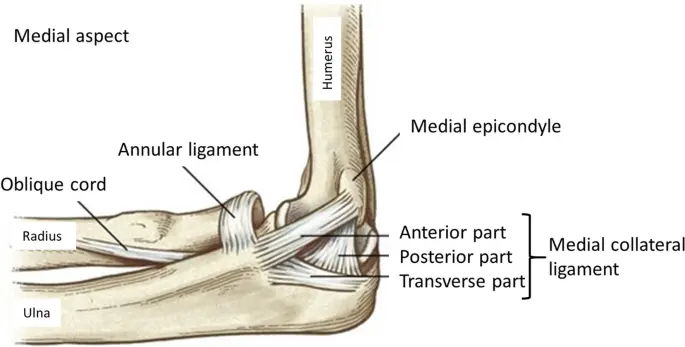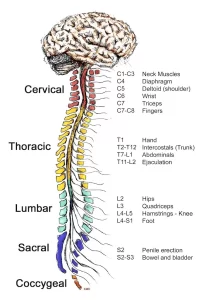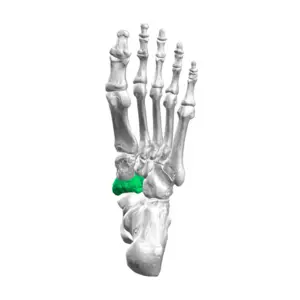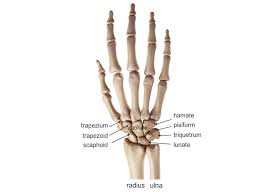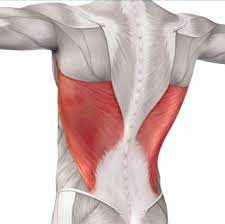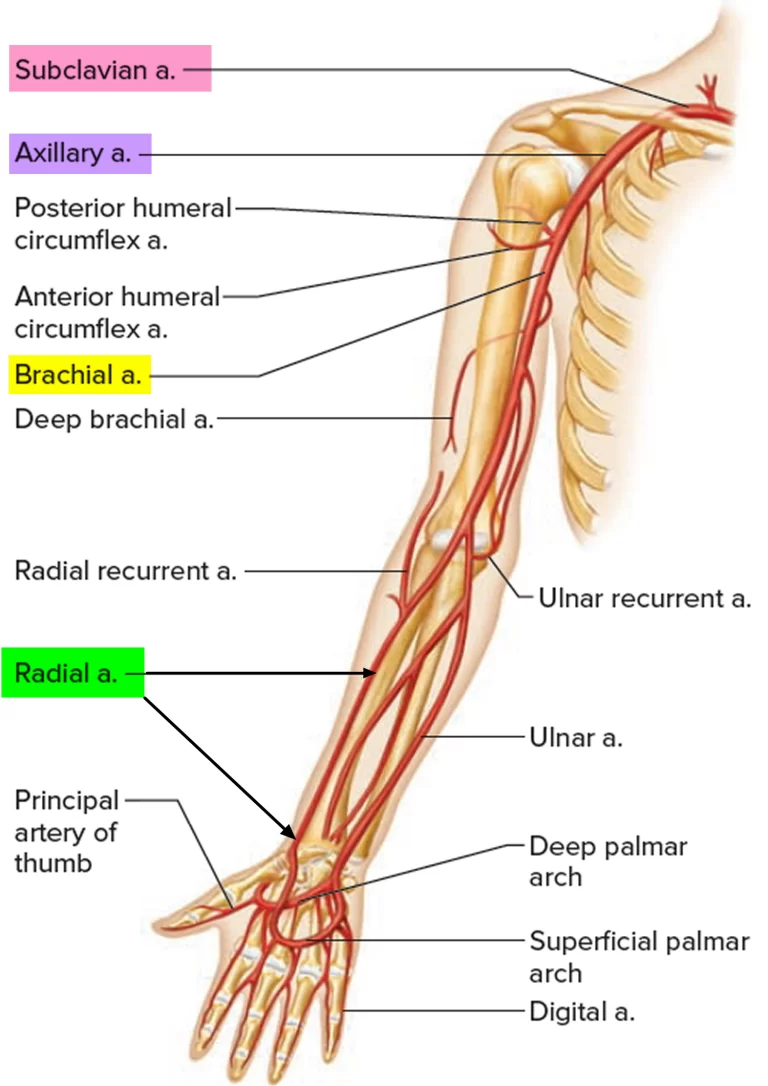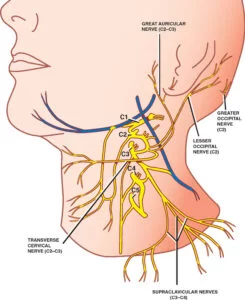Elbow Ligament
Table of Contents
Introduction
The elbow joint is a very complex joint that connects the upper arm bone humerus to the two bones in the forearm radius and ulna. The elbow ligament is a strong, fibrous band of tissue that surrounds and stabilizes the joint. It is made up of three main ligaments: the medial collateral ligament (MCL), the lateral collateral ligament (LCL), and the annular ligament.
The MCL is located on the inside of the elbow and helps to prevent the arm from bending too far inward. The LCL is located on the outside of the elbow and helps to prevent the arm from bending too far outward. The annular ligament surrounds the head of the radius bone and helps to keep it in place during movement.
The elbow ligament plays an important role in maintaining stability and allowing for smooth movement of the arm. Injuries to the elbow ligament can result in pain, instability, and limited range of motion.
Ligaments of the elbow joint
The elbow ligament is a complex network of fibrous tissue that surrounds and stabilizes the elbow joint. It is made up of three main ligaments:
- the medial collateral ligament (MCL)
- the lateral collateral ligament (LCL)
- the annular ligament
- the ulnar collateral ligament(UCL)
The MCL is located on the inside of the elbow and is responsible for preventing the arm from bending too far inward. It is composed of two parts, the anterior and posterior bundles, which work together to provide stability to the elbow joint. The MCL is the most commonly injured ligament in the elbow, often due to repetitive throwing motions in sports like baseball.
The LCL is located on the outside of the elbow and is responsible for preventing the arm from bending too far outward. It is composed of three parts, the radial collateral ligament, the lateral ulnar collateral ligament, and the accessory lateral collateral ligament. The LCL is less commonly injured than the MCL, but can still be damaged in traumatic injuries or overuse.
The annular ligament surrounds the head of the radius bone and helps to keep it in place during movement. It is a ring-shaped structure that allows the radius bone to pivot around the ulna bone, allowing for rotation of the forearm. Injuries to the annular ligament can result in instability and a limited range of motion in the elbow joint.
The UCL is located on the inside of the elbow and is responsible for stabilizing the joint during overhead throwing motions, such as those used in baseball pitching. This ligament is particularly important in athletes who engage in repetitive throwing motions, as it can become overstretched or torn over time.
Injuries of the elbow joint ligament
Injuries to the elbow ligaments can occur due to a variety of reasons, including overuse, trauma, or degeneration. The severity of the injury can vary from a mild sprain to a complete tear of the ligament.
- Medial collateral ligament (MCL) injury: MCL injuries are commonly seen in athletes who engage in throwing or twisting motions, such as baseball pitchers or tennis players. Symptoms of an MCL injury include pain on the inside of the elbow, swelling, and stiffness. In severe cases, there may be instability in the joint and difficulty in moving the arm.
- Lateral collateral ligament (LCL) injury: LCL injuries are less common than MCL injuries but can occur due to trauma or overuse. Symptoms of an LCL injury include pain on the outside of the elbow, swelling, and difficulty in bending the arm. In severe cases, there may be instability in the joint and difficulty in performing activities that involve pushing or pulling motions.
- Annular ligament injury: Annular ligament injuries are usually caused by a sudden twisting motion of the forearm. Symptoms of an annular ligament injury include pain and tenderness around the elbow joint, as well as difficulty in rotating the forearm.
- Ulnar collateral ligament (UCL) injury: UCL injuries are commonly seen in baseball pitchers due to repetitive throwing motion. Symptoms of a UCL injury include pain on the inside of the elbow, swelling, and difficulty in throwing or gripping objects. In severe cases, there may be instability in the joint and a feeling of weakness in the arm.
Examination test for the elbow joint ligament
There are several special tests that can be performed to diagnose elbow ligament injuries. These tests are usually performed by a medical professional, such as a doctor or physical therapist, and are designed to assess the stability and integrity of the ligaments in the elbow joint. Some common special tests for elbow ligament injuries include:
- The Valgus stress test
- The varus stress test
- The milking maneuver
- The moving valgus stress test
The Valgus stress test
The valgus stress test is a special test used to assess the stability of the medial collateral ligament (MCL) in the elbow joint. The MCL is situated on the inside of the elbow and helps to stabilize the joint during movements such as throwing or lifting.
During the valgus stress test, the patient’s arm is held at a 90-degree angle with the palm facing up. The medical professional performing the test will then apply pressure to the outside of the elbow while gently pulling the forearm away from the body. This creates stress on the MCL, which helps to assess its stability.
The medical professional will look for any excessive movement or pain during the test. If there is excessive movement, it may indicate an MCL injury. Pain during the test may also indicate an injury or inflammation in the MCL.
It is important to take in mind that the valgus stress test should only be performed by a trained medical professional. Attempting to perform this test at home or without proper training can cause further injury or damage to the elbow joint. If you suspect you have an elbow ligament injury, it is very crucial to take medical attention from a qualified medical professional.
The varus stress test
The varus stress test is another special test helpful to check the stability of the lateral collateral ligament (LCL) in the elbow joint. The LCL is located on the outside of the elbow and helps to stabilize the joint during movements such as throwing or lifting.
During the varus stress test, the patient’s arm is held at a 90-degree angle with the palm facing down. The medical professional performing the test will then apply pressure to the inside of the elbow while gently pushing the forearm toward the body. This creates stress on the LCL, which helps to assess its stability.
The medical professional will look for any excessive movement or pain during the test. If there is excessive movement, it may indicate an LCL injury. Pain during the test may also indicate an injury or inflammation in the LCL.
Like the valgus stress test, it is important to take in mind that the varus stress test should only be performed by a trained medical professional. Attempting to perform this test at home or without proper training can cause further injury or damage to the elbow joint. If you suspect you have an elbow ligament injury, it is important to take medical attention from a qualified medical professional.
The milking maneuver
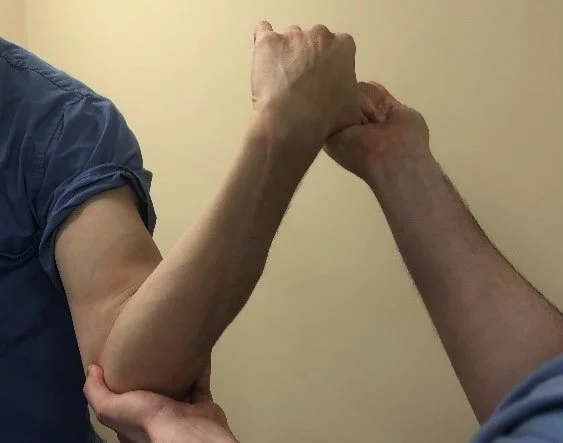
The milking maneuver is a special test used to assess the stability of the ulnar collateral ligament (UCL) in the elbow joint. The UCL is located on the inside of the elbow and helps to stabilize the joint during movements such as throwing or lifting.
During the milking maneuver, the patient’s arm is held at a 90-degree angle with the palm facing up. The medical professional performing the test will then place their thumb on the inside of the patient’s elbow, just below the bony prominence (medial epicondyle). The medical professional will then place their fingers on the back of the patient’s wrist.
The medical professional will then gently squeeze their fingers and thumb together while simultaneously pulling the patient’s wrist towards them. This creates a milking motion, which puts stress on the UCL and helps to assess its stability.
The medical professional will look for any excessive movement or pain during the test. If there is excessive movement, it may indicate a UCL injury. Pain during the test may also indicate an injury or inflammation in the UCL.
It is important to take in mind that the milking maneuver should only be performed by a trained medical professional. Attempting to perform this test at home or without proper training can cause further injury or damage to the elbow joint. If you suspect you have an elbow ligament injury, it is important to take medical attention from a qualified medical professional.
The moving valgus stress test
The moving valgus stress test is a diagnostic procedure used to assess the integrity of the medial collateral ligament (MCL) in the elbow joint. The MCL is a primary stabilizer of the elbow, preventing excessive valgus (outward) stress on the joint.
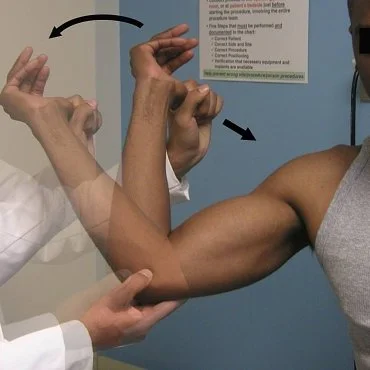
Here is a detailed explanation of how the moving valgus stress test is performed:
Patient Positioning: The patient is typically seated or lying down with the elbow flexed at 90 degrees and the forearm resting on a table or the examiner’s hand. The examiner stands next to the patient’s affected arm. Stabilization: The examiner places one hand on the patient’s forearm, just above the wrist, to stabilize it. The other hand is placed on the patient’s upper arm, just above the elbow, providing support and control during the test.
Starting Position: The examiner starts by applying gentle valgus stress to the elbow joint, pushing it in an outward direction. This initial stress helps to identify any pain or discomfort that may be present at rest. Passive Flexion: While maintaining the valgus stress, the examiner slowly and passively flexes the patient’s elbow from 20 to 120 degrees. The speed of flexion should be controlled and gradual to avoid causing any additional stress or discomfort. Palpation: During the flexion phase, the examiner palpates the medial aspect of the elbow joint for any signs of pain, tenderness, or instability. The presence of pain or excessive laxity may indicate an MCL injury. Repetition: The test is repeated several times, gradually increasing the amount of valgus stress applied to the elbow joint with each repetition. This helps to assess the tolerance and stability of the MCL at different degrees of flexion. Endpoint: The test is considered positive if the patient experiences pain or instability during the moving valgus stress test. The degree of pain and laxity can also be graded to determine the severity of the MCL injury.
It is important to take in mind that the moving valgus stress test should be performed by a trained medical professional, such as an orthopedic surgeon or a sports medicine specialist, to ensure an accurate interpretation of the results and to minimize the risk of further injury.
Treatment of the elbow joint ligament injuries
The treatment of elbow ligament injuries, such as MCL injuries, can vary depending on the severity and specific characteristics of the injury. However, there are several common treatment approaches that are often utilized. Here is a detailed explanation of the treatment options for elbow ligament injuries:
Conservative Treatment:
- Rest: The first step in treating an elbow ligament injury is usually to rest the affected arm and avoid any activities that may aggravate the injury. This may involve immobilizing the elbow with a brace or splint.
- Ice: do the Application of ice to the injured area can help decrease pain and swelling. Ice should be applied for about 15-20 minutes at a time, a few times a day.
- Compression: Wrapping the elbow with a compression bandage can help control swelling and provide support to the injured ligament.
- Elevation: Elevating the injured arm above heart level can also help reduce swelling.
- Medications: Over-the-counter nonsteroidal anti-inflammatory drugs (NSAIDs), such as ibuprofen, may be recommended to help manage pain and inflammation.
Physical Therapy:
- Once the initial pain and swelling have subsided, a physical therapy program may be prescribed to help restore strength, flexibility, and function to the injured elbow.
- Physical therapy exercises may include gentle range of motion exercises, stretching, strengthening exercises, and functional activities specific to the individual’s needs and goals.
- The physical therapist will guide the patient through the appropriate exercises and progress the program as the healing process allows.
Immobilization:
- In some cases, especially for more severe ligament injuries or if conservative treatment fails to provide sufficient healing, immobilization of the elbow joint may be necessary.
- This can be achieved with a cast, brace, or splint that restricts movement of the elbow joint and allows for proper healing of the ligament.
- The duration of immobilization will depend on the specific injury and the individual’s healing progress.
Surgical Intervention:
- In cases of severe or complete ligament tears, or if conservative treatment fails to provide satisfactory results, surgical intervention may be considered.
- The surgical procedure for elbow ligament injuries typically involves repairing or reconstructing the damaged ligament using various techniques and grafts.
- After surgery, a period of immobilization and protection is usually required, followed by a comprehensive rehabilitation program to regain strength, stability, and function in the elbow joint.
It is very important to consult with a medical professional, such as an orthopedic surgeon or a sports medicine specialist, to determine the most appropriate treatment approach for an elbow ligament injury. They will consider factors such as the severity of the injury, the individual’s activity level and goals, and any other associated injuries or conditions to develop a personalized treatment plan.
Physiotherapy treatment for the elbow joint ligament
Physiotherapy treatment for elbow ligament injuries aims to reduce pain, inflammation, and swelling, promote healing, restore range of motion, and improve strength and function of the affected arm. The treatment approach may vary depending on the specific injury and the individual’s needs, but here is a detailed explanation of some common physiotherapy techniques used:
Manual Therapy:
- Manual therapy techniques, such as joint mobilizations and soft tissue mobilizations, may be used to improve joint mobility and reduce muscle tightness or stiffness around the elbow.
- Joint mobilizations involve the physiotherapist gently moving the elbow joint in specific directions to help restore normal joint mechanics and reduce pain.
- Soft tissue mobilizations involve the physiotherapist using hands-on techniques to release tension in the muscles, tendons, and ligaments around the elbow.
Range of Motion Exercises:
- Gentle range of motion exercises are usually initiated once pain and swelling have subsided.
- These exercises aim to gradually restore normal movement of the elbow joint and prevent stiffness.
- The physiotherapist may guide the patient through exercises such as flexion and extension of the elbow, pronation and supination of the forearm, and gentle stretching of the surrounding muscles.
Strengthening Exercises:
- Once the range of motion has been restored, strengthening exercises are introduced to improve muscle strength and stability around the elbow joint.
- The physiotherapist will prescribe specific exercises targeting the muscles that support and stabilize the elbow, such as the biceps, triceps, and forearm muscles.
- These exercises may include resistance training using weights, resistance bands, or bodyweight exercises.
Neuromuscular Re-education:
- Neuromuscular re-education involves teaching the patient proper movement patterns and body mechanics to prevent further injury and promote optimal function of the elbow.
- The physiotherapist may use techniques such as proprioceptive training, balance exercises, and functional activities to improve coordination, control, and stability of the elbow joint.
Modalities:
- Modalities such as ultrasound, electrical stimulation, or LASER therapy may be used to help reduce pain, inflammation, and swelling in the early stages of treatment.
- These modalities can also promote tissue healing and provide temporary relief from symptoms.
Functional Rehabilitation:
- As the healing process progresses, the physiotherapist will incorporate functional activities and sport-specific exercises into the rehabilitation program.
- This may involve simulating the movements and demands of the individual’s specific sport or daily activities to ensure a safe return to full function.
Throughout the physiotherapy treatment process, the physiotherapist will continuously assess the individual’s progress, modify the treatment plan as needed, and provide education on injury prevention strategies and self-management techniques. It is essential to follow the physiotherapist’s instructions and adhere to the prescribed exercises and rehabilitation program for optimal recovery.
Risk factors for the elbow joint ligament injuries
There are several risk factors that can increase the likelihood of developing elbow ligament injuries. These include:
- Overuse or Repetitive Strain: Engaging in repetitive activities that involve excessive or prolonged use of the elbow joint, such as throwing, pitching, or repetitive gripping, can place excessive stress on the ligaments and lead to injury.
- Sports Participation: Participating in certain sports that involve repetitive or forceful movements of the elbow joint, such as baseball, tennis, golf, or weightlifting, can increase the risk of elbow ligament injuries.
- Poor Technique or Form: Using incorrect technique or form during sports or activities that involve the elbow joint can put additional stress on the ligaments and increase the risk of injury. This can be seen in improper throwing or swinging motions, for example.
- Lack of Conditioning or Strength: Insufficient strength and conditioning of the muscles that support and stabilize the elbow joint can lead to increased stress on the ligaments and make them more susceptible to injury.
- Previous Elbow Injuries: Individuals who have previously experienced elbow injuries, such as a previous ligament sprain or dislocation, may be at a higher risk of developing future ligament injuries due to weakened or compromised ligaments.
- Age: Ligament injuries may be more common in older individuals due to age-related changes in the tissues, such as decreased elasticity and strength of the ligaments.
- Improper Warm-up or Cool-down: Failing to adequately warm up before engaging in physical activity or neglecting to properly cool down afterward can increase the risk of ligament injuries.
- Poor Equipment or Technique: Using equipment that is not properly fitted or maintained, such as a tennis racket with an improper grip size or worn-out strings, can contribute to increased stress on the ligaments. Additionally, using incorrect techniques during activities can also increase the risk of injury.
How to prevent injuries
To prevent elbow ligament injuries, it is important to take proactive measures and incorporate the following strategies:
- Maintain Proper Technique and Form: When participating in activities that involve the elbow joint, such as throwing, swinging, or lifting, it is crucial to use proper technique and form. This includes using the correct body mechanics, maintaining good posture, and following the recommended movement patterns. Seek guidance from a coach, trainer, or sports specialist to ensure proper technique.
- Gradually Increase Intensity and Duration: Avoid sudden spikes in activity level or training intensity. Gradually increase the intensity, duration, or frequency of activities to allow your ligaments and muscles to adapt and strengthen over time. This gradual progression helps prevent overuse injuries.
- Warm-up and Cool-down: Always warm up before engaging in physical activity to increase blood flow to the muscles and prepare them for exercise. Incorporate dynamic stretches and movements that specifically target the muscles around the elbow joint. Similarly, cool down after activity with static stretches to help reduce muscle tightness and promote recovery.
- Strengthen the Surrounding Muscles: Focus on strengthening the muscles that support and stabilize the elbow joint, such as the forearm muscles, biceps, triceps, and shoulder muscles. A well-rounded strength training program can help improve overall joint stability and reduce the stress on the ligaments.
- Cross-Train and Vary Activities: Engaging in a variety of activities can help prevent overuse injuries by distributing the stress on different muscle groups and joints. Incorporate cross-training exercises that target different muscle groups and alternate between high-impact and low-impact activities to reduce repetitive strain on the ligaments.
- Use Proper Equipment: Ensure that any equipment used during activities is properly fitted, maintained, and appropriate for the specific activity. For example, using a tennis racket with the correct grip size can help distribute forces evenly across the hand, wrist, and elbow. Replace worn-out or damaged equipment to minimize the risk of injury.
- Take Rest and Recovery Days: Allow your body sufficient time to rest and recover between intense training sessions or activities. Adequate rest helps prevent overuse injuries and allows the ligaments and muscles to repair and strengthen.
- Listen to Your Body: Pay attention to any warning signs of pain, discomfort, or fatigue in the elbow joint. If you experience persistent or worsening symptoms, modify or reduce your activities, and seek medical advice if necessary.
- Maintain Overall Fitness and Health: A healthy lifestyle, including regular exercise, proper nutrition, adequate sleep, and stress management, can contribute to overall joint health and reduce the risk of injuries.
FAQs
Some common elbow ligament injuries include medial collateral ligament (MCL) sprains or tears, lateral collateral ligament (LCL) sprains or tears, and ulnar collateral ligament (UCL) injuries.
Elbow ligament injuries can occur due to repetitive stress, overuse, or trauma. They are often seen in athletes who participate in throwing sports such as baseball, tennis, or javelin throwing. These injuries can also occur from sudden impact or forceful twisting motions.
Symptoms of an elbow ligament injury may include pain, swelling, instability, a popping or clicking sensation, limited range of motion, and difficulty gripping or holding objects.
It is advisable to take medical attention if you experience severe pain, swelling, or instability in your elbow joint. If you are unable to move your elbow or if the pain persists despite rest and self-care measures, it is important to consult a medical professional.
Elbow ligament injuries are typically diagnosed through a physical examination and medical history assessment. Additional diagnostic tests such as X-rays, MRI scans, or ultrasounds may be ordered to assess the extent of the injury and rule out other possible conditions.
Treatment options for elbow ligament injuries may include rest, ice, compression, and elevation (RICE), nonsteroidal anti-inflammatory drugs (NSAIDs) for pain relief, physical therapy, bracing or splinting, and in some cases, surgery. The appropriate treatment depends on the severity of the injury and individual factors.
Yes, elbow ligament injuries can be prevented by following the proactive measures mentioned above, such as maintaining proper technique and form, gradually increasing intensity, warming up and cooling down, strengthening surrounding muscles, cross-training, using proper equipment, taking rest and recovery days, and maintaining overall fitness and health.
The recovery time for an elbow ligament injury varies depending on the severity of the injury and the chosen treatment approach. Mild to moderate injuries may take several weeks to a few months to heal, while more severe injuries or surgical interventions may require a longer recovery period of several months to a year.
Yes, there is a risk of recurring elbow ligament injuries, especially if proper preventive measures are not followed or if there is a premature return to activities without sufficient healing and rehabilitation. It is important to continue with appropriate strengthening exercises and maintain good technique to reduce the risk of recurrence.

